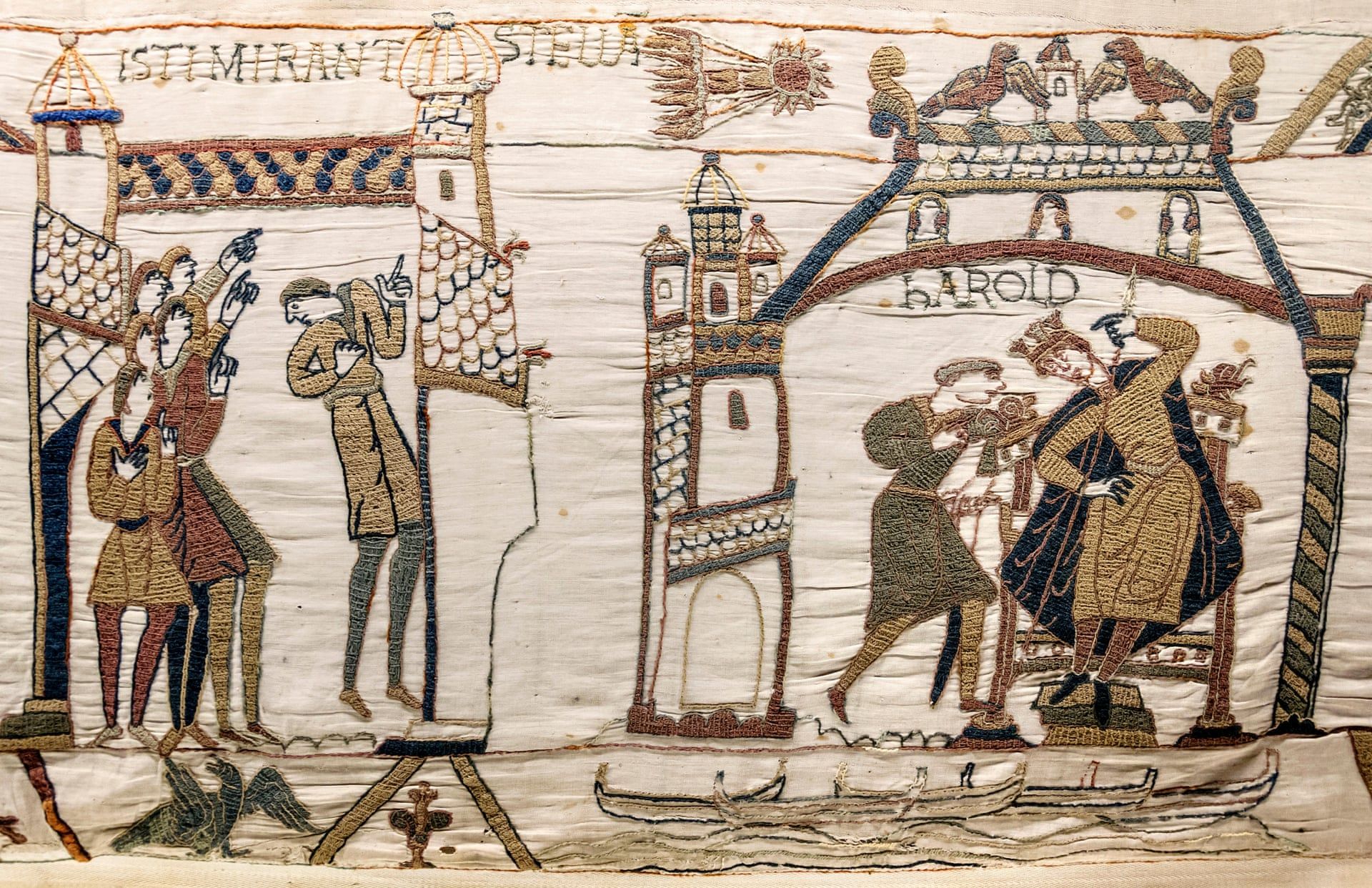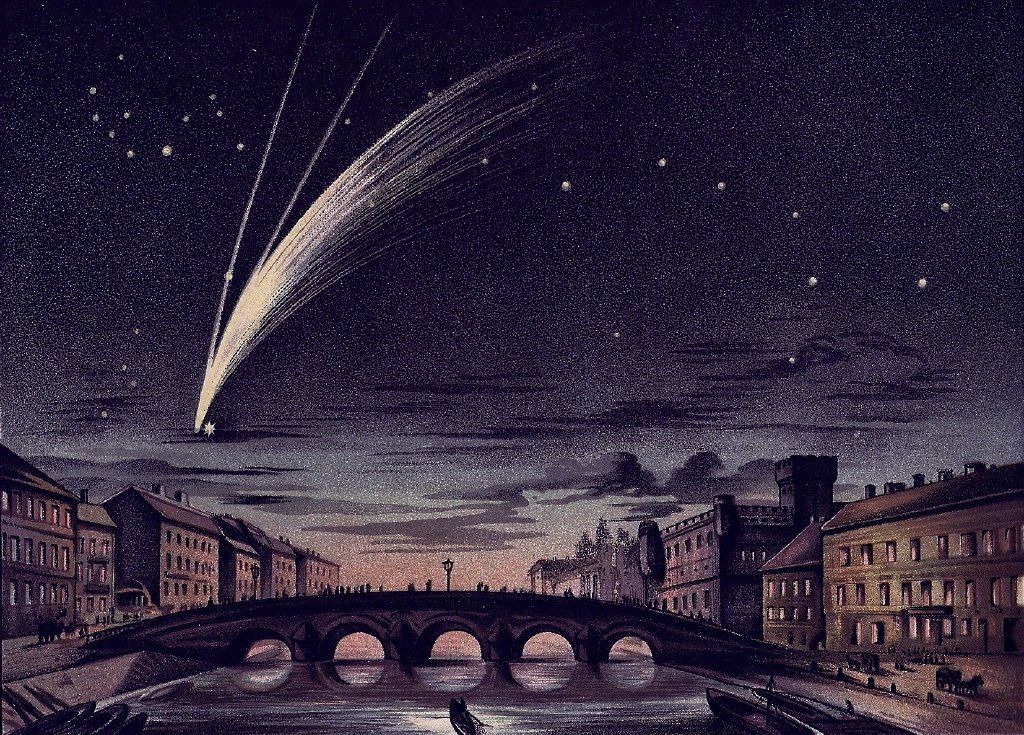This web page is created within BALTICS project funded from the European Union’s Horizon2020 Research and Innovation Programme under grant agreement No.692257.
The largest comets before the 20th century
Watching the starry sky has probably been an integral part of the life of an intelligent person since ancient times. The life of our ancestors was determined by two main objects – the Sun and the Moon. The stars, which formed permanent and persistent figures that later became constellations, provided reliable information about changing seasons and helped to plan daily work, as well as orientate in areas. Although variable, the planets were also predictable, with people trying to explain the fates of people, countries and even events.
Much greater fear of people in ancient times was inspired by the changing phenomena observed in the sky – eclipses, meteor streams and also comets. Their unpredictable behavior was associated with disasters, defeats, disease, and even the possible destruction of the world.
The word “comet” itself comes from the Greek language and means “hairy”. The first records of these objects, which were originally considered to be atmospheric phenomena, can be found in the documents of ancient Chinese scientists, which were created about 600 BC. Many centuries earlier than European scientists, observers in ancient China noticed that the tails of comets were always facing away from the Sun. Thanks to detailed observations by Chinese astronomers and astrologers, the orbits of many comets have been reconstructed and clarified.
Halley’s Comet is one of the short-lived comets, the appearance of which is regularly documented in various historical records. For example, it was visible in the 12 BC and therefore this appearance is often associated with a star mentioned in the Bible as a sign that Jesus was born. One of the oldest drawings of a particular comet is considered to be the representation of the Halley’s Comet in the Nuremberg Chronicles, which dates back to 684 AD. In 837, the Halley’s Comet flew the Earth at a distance of just 5 million kilometers, and its appearance was observed by astronomers both in Europe and in the East. Another representation of this comet can be found in the famous Bayeux tapestry, which shows the appearance of this comet in 1066.
Although the Halley’s Comet was notable for its regularity, some comets became notable for their brilliance. This was the 44 BC observed comet or Caesar’s comet. The ancient Romans interpreted its appearance not as a messenger of adversity, but as a sign that the recently assassinated ruler Julius Caesar is a divine being. This comet was visible even during the day. The perihelion of the comet could be 0.22 astronomical units away from the Sun. If its orbit is parabolic, the comet is now more than 800 astronomical units away from the Sun. However, it cannot be ruled out that the comet, flying past the Sun, has broken into pieces.
The Great Comet is interesting, which was observed in 1106 in the period from February to March. Astronomers in both Europe and Asia wrote about this comet. Evidence from Chinese scientists has found that this comet split into several fragments, which in later centuries were observed near the Earth as separate bright comets. Ancient Chinese astronomers have also recorded the length of the tail – about 60 degrees.
People’s understanding of comets practically remained unchanged until the 16th century. It was believed that comets, which are pockets of hot and poisonous vapors in the atmosphere, can cause disasters on Earth of various scales – earthquakes, diseases and famine.
The appearance of the comet in 1264 confirmed this view, because in July, when the comet was first observed with the naked eye, Pope Urban IV fell ill. The Pope died on October 2, 1264, when the comet also disappeared. This was a shiny comet with a bright tail that stretched at least 100 degrees.
Some scientists believe that the Comet of 1264 is the same one that appeared in 1556, however, no evidence has been found to support this claim. The 1556 Comet, in turn, is thought to have caused at least one strong earthquake in China. It is considered to be the most catastrophic earthquake, killing around 830,000 people. In Europe, however, Emperor Charles V saw it as a sign that it was time to leave the throne and moved to a monastery.
Only at the end of the 16th century, when Tycho Brahe made observations of a bright comet at the end of 1577, did the scientist’s mathematical calculations reveal that the comet was at least 6 times farther from the Earth than the Moon. This was not a periodic comet, so it has not been observed again. It is estimated that it could currently be about 320 astronomical units away from the Sun.
In this way, comets turned from the phenomenon of gases into the atmosphere into cosmic objects that, as scientists calculated in the 17th century, move in elongated orbits around the Sun.
One of the brightest comets of the 17th century was seen in 1680-1681, which is the first telescopically discovered. On November 14, 1680, Gottfried Kirch noticed it in his telescope. On November 30, 1680, it passed the Earth at a distance of 0.42 AU, but on December 18, it was in the perihelion at a mere 0.0062 AU. It was visible even during the day, but at night the comet delighted the observers with a tail that was at least 70 degrees long. Interestingly, this comet was observed not only in Europe, but also in South America, where the Jesuit priest Eusebio Kino was located at that time, who thus became the first European to publish a scientific treatise in the American continent. The last time the comet was seen was on March 19, 1681. At present, it could be about 257 AU from the Sun.
Based on these assumptions, Edmund Halley calculated the orbits of several comets and calculated the next time we would see the bright comet we saw in 1682, which we now know as Halley’s Comet.
In the following centuries, calculating the orbits and perihelia of comets was already a common practice. As the tools used by astronomers to look at the sky improved, it was possible to focus on the study of the structure of the comets themselves. At the beginning of the 19th century, Olbers and Bessel explained the mechanisms of comet tail formation, but a little later Giovanni Schiaparelli proved that comets are associated with specific meteor streams.
In 1744, another Great Comet visited the Earth, which was clearly visible to the naked eye. It was discovered at the end of November 1743. On February 18, 1744, the comet was as bright as Venus and had two tails. After reaching perihelion (0.2 AU) on March 1, 1744, it had six tails.
Although comets with several tails were observed in the past, the Great Comet of 1744 was a record holder. The maximum observed star size is rated as “7”. The comet left the northern hemisphere at the beginning of March 1744, but was observed in the southern hemisphere until April 22, 1744. This comet has inspired one of the most famous comet hunters – Charles Messier.
The Great Comet of 1811, which was discovered on March 25, 1811, has inspired many artists and writers. Leo Tolstoy described it in his novel War and Peace. It was believed that this comet, which was visible to the naked eye for 260 consecutive days, heralded the French Emperor Napoleon’s march to Russia. However, some people saw this phenomenon as a business opportunity. These were French winemakers who in 1811 experienced a particularly good grape harvest. “Comet wine” was hailed as a special quality, and it was included in the collections of the rulers of many countries. It is estimated that the core of the comet could have been 30-40 km in size. Its orbital period is about 3600 years.
The list of large comets cannot fail to mention the Comet Donati, which was noticed on June 2, 1858 by the Italian astronomer Giovanni Battista Donati. It could be seen with the naked eye from mid-August to November. It was still visible in the telescope on March 4, 1859. This is the first comet photographed. The Comet Donati is a long-period comet that could return to Earth around 3046 (orbital period about 1740 years). This comet was very well observed in the northern hemisphere and its visit was accompanied by particularly good weather in September and October 1858.
Probably the brightest comet was observed in September 1882. This comet belongs to the Kreutz group. They are comets that pass past the Sun at a distance less than the radius of the Sun, and are thought to have formed when a larger comet split into fragments several centuries ago. Kreutz group comet aphelion is located about 170 AU from the Sun. It was originally seen in the southern hemisphere. The comet is already mentioned in the reports on September 1. The Great Comet of 1882 before and after perihelion could be observed during the day near the Sun. In the perihelia, the comet was on September 17 and passed the Sun at a distance of 0.0032 AU. At the Royal Observatory in Cape Town, the comet’s approach to the Sun was observed by telescope using a special filter. As early as the end of October, it was clear that the comet’s visit to the Sun had split its nucleus into at least five fragments. The comet was visible to the naked eye until February 1883.
The list of large comets must end with the comet observed in early January 1910, which surpassed Venus in brilliance. It quickly became brighter and already on January 17 it could be seen during the day. Perihelia reached 0.13 AU from the solar comet on January 17. The comet’s brightness then dimmed, but observers reported a beautiful tail that stretched about 50 degrees.
In 1910, the Halley comet was also expected to appear. Therefore, the comet observed in January caused confusion and misunderstanding. Although comets were already fairly well-studied objects in the early 20th century, people were still afraid of them. During the appearance of the 1910 Halley’s Comet, the people of Chicago covered their windows to protect themselves from the poisonous fumes of the Comet’s tail, as scientists had discovered the presence of hydrogen cyanide in the Halley’s Comet’s tail.























